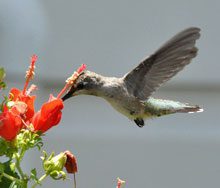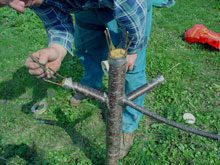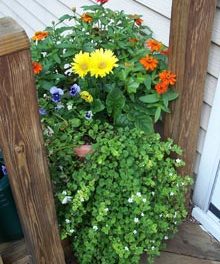 It’s time we had a little talk – that talk. You’ve reached that stage in life when you notice things are changing; there are times when you feel an overwhelming urge; I want you to go out there feeling confident, aware, and prepared, and I want you to understand just what is going on, so that you can be a responsible and caring person. Reproduction is a very complex process, and it is important to realize it is not all about sex. There is so much more.
It’s time we had a little talk – that talk. You’ve reached that stage in life when you notice things are changing; there are times when you feel an overwhelming urge; I want you to go out there feeling confident, aware, and prepared, and I want you to understand just what is going on, so that you can be a responsible and caring person. Reproduction is a very complex process, and it is important to realize it is not all about sex. There is so much more.
But sex is where we’ll start. You know, that “birds and bees” stuff seems kind of silly – yeah, bees are famous pollinators, essential for the seed-forming process of so many plants. But birds play roles in the process, too, as do some bats.
The essential fact for sexual reproduction might be described most simply as having the pollen from the male part of one flower placed on the female part of another flower; this vital transfer can happen in a number of ways: birds, bees, and bats; moths; the wind; even the careful use of a soft little paintbrush can fertilize a flower. If the conditions are right, if the transfer works, the flower is fertilized, and a seed or many seeds form to carry on the genes of both parent plants.
That latter fact is crucial. Sexual reproduction recombines the genetic qualities of each parent, so the offspring that grow from the seed of such a union are never identical in every way to either parent. This is a superb method for improving a crop or garden plant over generations, selecting each time the plants with the most desired qualities to be the parent plants for the next generation. Or it can be the method by which serious flaws – like disease susceptibility – can be passed on.
Once seed has formed and matured, distribution becomes an issue for getting the seeds to where they can grow. Again birds often help, and mammals do, too, when they consume the seed-containing fruit and then eliminate the seeds when they pass through the digestion process. Sometimes, the digestion process is necessary for the seed to germinate once eliminated.
Wind is often a method for distribution of light, airy seeds; seeds with burr-like coverings are often transported by furry animals. And some seeds are sharp and pierce the skin or clothing of unwilling carriers, traveling long distances before being shed.
The gardener might be the one who does the transporting, however, and often is the one responsible for choosing the ideal landing spot for seed to take a firm hold and grow into healthy, desirable garden plants and crops.
But I don’t want to get stuck on sexual stuff. As I said, there’s so much more. I’ll call it asexual reproduction; some people call it cloning; there are other names for the particular techniques used. All of it, though, is done without involving the transfer of genes for recombination – there’s no sex involved, so there’s none of the benefit and challenge of reproducing plants through sexual means.
One such method is by rooting cuttings. Parts of a plant (it could be the stem or the root) are cut, sometimes a hormone is applied, and then inserted into an appropriate medium to await formation of roots. Once the roots form, growth usually begins, and a new plant – usually identical to the parent plant from which it was cut – is made.
Rooting cuttings takes some skills, such as knowing when a particular plant is most likely to make new roots, what kind and how much hormone is best, and what conditions are most conducive to root formation and growth.
Another asexual method is known as air-layering, which involves damaging part of the stem of a plant, securely wrapping a suitable medium around the stem and enclosing the ball with a sealing wrap, and waiting for roots to form on the stem. Once sufficiently rooted, the growing stem is removed from the mother plant and grown on its own.
Somewhat similar to air-layering is the method called simply layering, in which a branch of a plant is bent low enough to be buried just below the ground. The stem is damaged deliberately, as in air-layering, and the wounded section is placed under the soil, kept undisturbed, covered and moist, until roots form on the stem section that is buried. Then the new plant is cut from the parent plant and grown on its own. My grandmother made hundreds of azaleas for her garden in precisely this way.
Grafting is another method of propagating plants asexually. This method takes an already- growing plant, called the root-stock, and inserts into the already growing stem a segment cut from another plant. The inserted segment, called the scion, could be a growing bud or a small stem inserted into the side of the root-stock’s larger stem; or it could be one or more growing stems which are shaped to fit a notch cut into the full stem of the rootstock. The joint, or graft, is carefully sealed and protected to enable the stems of both plants to grow together, the roots of the old plant supplying the nutrients for the new scion’s growth. This method can even permit several varieties of fruit to grow on one tree.
growing plant, called the root-stock, and inserts into the already growing stem a segment cut from another plant. The inserted segment, called the scion, could be a growing bud or a small stem inserted into the side of the root-stock’s larger stem; or it could be one or more growing stems which are shaped to fit a notch cut into the full stem of the rootstock. The joint, or graft, is carefully sealed and protected to enable the stems of both plants to grow together, the roots of the old plant supplying the nutrients for the new scion’s growth. This method can even permit several varieties of fruit to grow on one tree.
Other asexual means of reproducing plants include division – in which a clump of plants are separated and grown separately – and leaf cuttings.
These asexual propagation methods create clones – exact copies – of the parent plant; they can multiply desirable plants with confidence, while sexual reproduction by seeds will introduce variation. Both approaches have powerful merits and some less desirable characteristics.
By the strangest of coincidences, the Lowcountry Master Gardener Association and Clemson Extension are offering advanced training in propagation for certified SC Master Gardeners. That’s all the encouragement you need to join the hundreds of Beaufort County citizens who have taken the full Master Gardener course and are eligible for this advanced course; for those who are qualified, the course is open statewide to Master Gardeners. For those who aren’t, take the Master Gardener course!
The course will involve four classes, will consume a full day on Friday, June 24, and will take place on the Bluffton campus of USCB. To sign up (I think there are a few spaces left for the course – it is offered statewide, and the attendance is limited) go to the Lowcountry Master Gardeners website, lowcountrymga.org and click on the Advanced Training link.
Pictured above:
A hummingbird pollinates a Turk’s Cap bush. (Photo by Nancy Castillo)
Grafting a Cherry Tree








